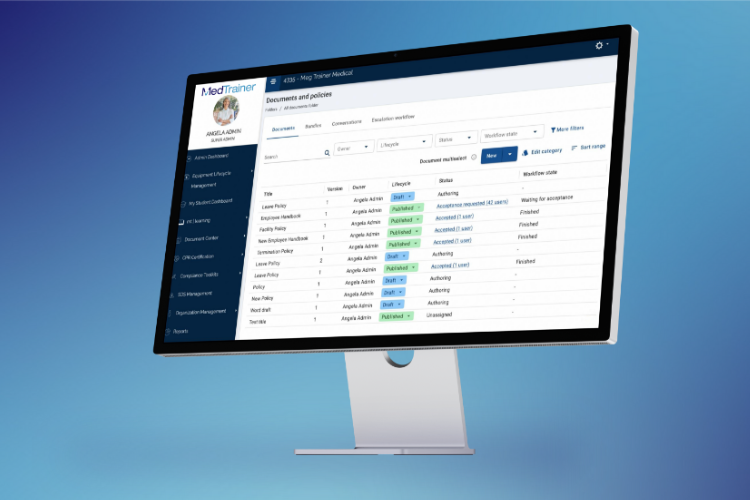Managing risk in a healthcare setting is a big responsibility. And while everyone has their own role to play in addressing risk, the duty of creating organization-wide risk mitigation strategies falls to the Chief Risk Officer (CRO).
There needs to be someone whose full-time job is to identify, assess, and address risk, to safeguard the integrity of care delivery and the reputation of the organization. The CRO is that person. Here’s a closer look at how they do it.
What Is a Chief Risk Officer?
The Chief Risk Officer (CRO) is a C-level executive who’s responsible for overseeing and managing risks associated with healthcare operations. They play a vital role in ensuring regulatory compliance, patient safety, and general risk mitigation. Some of the objectives commonly aligned with the CRO position include:
- Develop and implement risk management strategies
- Monitor compliance with regulations
- Handle insurance and claims management
- Promote patient safety initiatives
- Manage crises and disasters
- Communicate risks to stakeholders
Ultimately, the primary goal of the CRO is to proactively address risks to mitigate or avoid them. In doing so, they’re instrumental in creating a safe and secure healthcare environment.
What Are the Responsibilities of a Chief Risk Officer in Healthcare?
The scope of risk management will differ across every healthcare organization and facility. That said, organizations that are large enough to appoint a full-time CRO commonly have the same level of demand for risk management and compliance. As a result, there are often clear-cut responsibilities for the CRO, including:
- Risk assessment and management. The CRO identifies potential risks and assesses their impact on patient safety, regulatory compliance, financial stability, and reputation. They develop strategies to manage and mitigate these risks, often working closely with other executives, clinical leaders, and department heads.
- Compliance and regulatory oversight. Healthcare organizations are subject to numerous regulations and guidelines. The CRO ensures that the organization adheres to these requirements and implements appropriate policies and procedures to maintain compliance. They stay updated on relevant regulations and assess the organization’s adherence to them.
- Patient safety initiatives. The CRO is responsible for promoting and overseeing patient safety initiatives within healthcare facilities. They work to minimize adverse events, prevent medical errors, and implement systems and protocols to enhance patient safety. This can involve analyzing patient safety data, implementing quality improvement initiatives, and fostering a culture of safety throughout the organization.
- Insurance and claims management. The CRO handles the organization’s insurance policies, including liability coverage and malpractice insurance. They oversee claims management processes, and work closely with legal teams and insurance providers to handle any potential claims or litigation.
- Crisis management and disaster preparedness. Healthcare organizations need to be prepared for various crises and disasters. The CRO develops and maintains comprehensive crisis management and disaster preparedness plans. They coordinate responses during emergencies — such as natural disasters or disease outbreaks — and ensure the organization continues to deliver essential services while managing risks.
- Risk communication and education. The CRO plays a crucial role in communicating risks to relevant stakeholders: the executive team, providers, and staff. They provide education and training on risk management strategies, regulatory compliance, and patient safety protocols to ensure everyone is informed and empowered to assist in risk mitigation efforts.
How Does Technology Help a Chief Risk Officer?
Technology is a critical part of every CRO’s repertoire of risk mitigation tools. For example, a unified compliance platform puts all policies and documents in one place for employees. Meanwhile, a learning management system makes it easy to assign training when a trend in incidents is noticed or when employees may not be closely following policies.
Here’s a look at some of the other ways CROs can leverage technology to improve risk management and compliance within an organization:
- Data Analytics. Technology enables CROs to collect, analyze, and interpret vast amounts of data related to risk. Advanced analytics tools can identify patterns, trends, and outliers, to provide valuable insights for risk management. CROs can leverage data analytics to identify potential risks, monitor performance indicators, and make data-driven decisions to mitigate risks effectively.
- Risk Assessment Tools. Risk assessment software and tools streamline the process of identifying, evaluating, and prioritizing risks. They often include risk scoring methodologies, automated risk assessment templates, and customizable workflows. By using these tools, CROs can perform comprehensive risk assessments.
- Compliance Monitoring and Reporting. Compliance management software helps track regulatory changes, automate compliance checks, and generate reports. CROs can leverage technology to establish audit trails, monitor adherence to policies and procedures, and streamline compliance reporting. It adds up to a reduction in the risk of non-compliance and associated penalties.
- Incident Reporting and Tracking. Incident management software documents and analyzes incidents, near-misses, and errors. These systems help in identifying root causes, implementing corrective actions, and tracking the progress of risk mitigation efforts. By having a centralized incident reporting system, CROs can ensure timely response and effective resolution of issues.
- Communication and Collaboration. Secure messaging platforms and collaboration software enhance communication among the risk management team and other stakeholders. CROs can efficiently communicate risk alerts, share important information, and coordinate risk response efforts in real-time.
- Training and Education. Online learning platforms, webinars, and e-learning modules help disseminate information, share best practices, and enhance staff knowledge and awareness of risks. CROs can leverage a learning management system (LMS) to deliver targeted and interactive training programs, to ensure that employees are well-informed about risk mitigation strategies.
Streamline your compliance with MedTrainer
MedTrainer Is a CRO’s Best Friend for Compliance!
CROs shoulder a lot of responsibility when it comes to identifying, assessing, and managing risk. It’s important for healthcare organizations to support them with the tools they need to be effective — especially when it comes to digital compliance resources. That means exploring the many resources MedTrainer has to offer.
MedTrainer gives Chief Risk Officers everything they need to manage risk at the enterprise level: from centralized documentation and reporting capabilities, to compliance training modules and tracking features. We help CROs develop compliance across the organization, to minimize risk wherever it exists. Schedule a demo today to experience MedTrainer for yourself.

